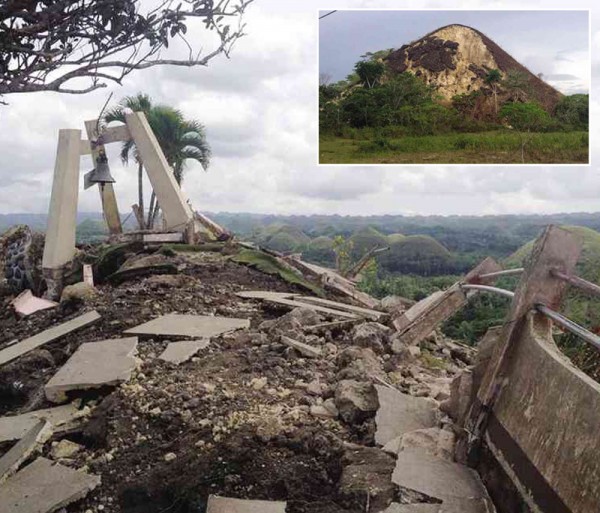
CHOCOLATE HILLS The observation deck used to view Bohol’s famous Chocolate Hills lies in ruins after the earthquake. Inset is one of the hills. PHOTOS FROM ROBERT MICHAEL POOLE’S TWITTER ACCOUNT
TAGBILARAN CITY, Philippines—In the municipality of Sagbayan in the the province of Bohol, grade-school students and teachers were trying very hard to get their lives back to normal.
This, despite the destruction of concrete structures of Sagbayan Elementary School during the 7.2 magnitude earthquake last month and left teachers with no other options but to conduct classes in makeshift classrooms.
Still reeling from the tragedy, evacuees were sent out of classrooms that served as evacuation centers in preparation for Supertyphoon Yolanda (international name Haiyan) that ravaged the country last week.
“They sent us out of here including evacuees from the quake,” Apolinario Torrefranca, a grade-school teacher said.
During tropical depression ‘Wilma,’ waters rose to knee deep in Sagbayan. When Yolanda was about the come, the government took all means in sending out the evacuees.
It also meant that the workers had to stop building the makeshift tents as classrooms for the meantime in preparation for Yolanda. These tents were a combined contribution of the government, parents’ and teachers’ money.
“Our situation is hard in Sagbayan. As teachers, we are having a hard time to return to normal because we don’t have enough tents. We also don’t have enough materials,” Torrefranca said.
Classes were out for almost three weeks after the Oct. 15 earthquake. The grade school teacher said that not all of the students have showed up to their classes that resumed Nov. 5 and was later cancelled again because of Yolanda, one of the strongest storms to make landfall in history.
They were told that classrooms will be rebuilt but it would take up to six months.
“To return back to normal we will need new classrooms and new materials. We need help and guidance from the government,” Torrefranca said.
‘Pre-emptive evacuation’
“It was good that we applied pre-emptive evacuation because the warnings were clear. The President addressed the nation and we took the warnings seriously. The earthquake had no warning,” Bohol Governor Edgar Chatto said.
After ‘Wilma,’ the local officials already worked on addressing the floods. They assumed the floods were caused by an incorrectly built road project and repaired it. When the monster typhoon Yolanda came, it flooded no more despite the heavy rains.
Although the province was spared directly of Yolanda and left zero casualty, Bohol was left “literally powerless.” Power lines in Leyte and Samar were knocked out, where Bohol is interconnected with.
“We were told that it will take 45 days up to two months to restore power,” Chatto said, adding that they rely on local power produce which only produces a small percent of power demand.
“Sometimes if there is no electricity, tourists back out in the hotels when they find out that there is no power,” he said.
The earthquake last month also knocked off powerlines. It was restored only recently but it went off again.
One month after
Exactly a month after the powerful earthquake, Chatto said they were starting to pick up the pieces after the tragedy.
The tremor cost P525 billion worth of damage, based on the local government assessment.
Although Chatto claimed that tourism remained high, a van-for-hire driver who spoke under the condition of anonymity said the earthquake was really a big blow to the province’s tourism.
“During low season like this, I would get around P400/net a day for driving around tourists. But now I only get as high as P200/net.
During peak season, he earns up to P1,000/net a day.
Some of its tourist destinations, its centuries-old churches, collapsed from the quake.
“The experts will recommend whether it will be restored or make use of what is left with the churches. But then the relics it should be preserved. It would be reminder of Bohol’s experience during the quake. This will remain as part of our tourist destinations,” Chatto said.
A partially destroyed Chocolate Hills remained a tourist spot as it also revealed limestones and fossils of marine life, he added.
“They like to take pictures of it,” Chatto said.
Aftershocks also continued to be felt a month after, but the official said it has become lesser and lower in magnitude.
The disaster came with lessons learned, Chatto said, among them was that you can never be prepared enough until the test will come.
“We have Tarsier 117 and it’s like the 911 here. It had been reliable but what we did not foresee was we will lose communication because of the earthquake unlike a typhoon that we could predict,” Chatto said.
RELATED STORIES:
There’s ‘opportunity in tragedy’ in Bohol
Bohol town residents find sanctuary in cave
Bohol earthquake creates miles-long rocky wall